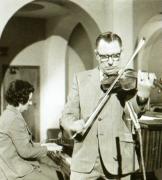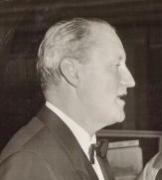|
|
||||||||||||||||||||||||
 |
Featured person
Recently added |
Seán McGuire (1927 - 2005): |
||||||||||||||||||||||

|
| Sean McGuire |
Sean McGuire is regarded by many as possibly the greatest fiddler ever to play traditional music.
Born Sean Stephen Maguire on 26 December 1927, he later changed his name to McGuire. His father, John, from Co. Cavan, who had come to Belfast to work in 1918, was an accomplished musician with his own ceilidh band. John played piccolo, concert flute, whistle and fiddle. It was a musical family; Sean’s brother Jim was a fiddle player and they recorded an album together in 1982.
Sean began his fiddle playing at age 12 when he began studying the classical violin. His teachers were Professor George Vincent, from whom he learned fingering and Madam May Nesbitt from whom he acquired his remarkable bowing style. He always regarded that start as one of his greatest assets, attributing his remarkable technique to 'my two brilliant teachers'. Sean later recalled how, under Madam Nesbitt’s watchful eye, he was required to practise bowing techniques for a full six months before progressing to playing actual tunes.
McGuire was only fourteen when his violin playing was broadcast for the first time on BBC radio. As a teenager he was first violinist with the Belfast Youth Orchestra and he turned down an invitation to join the Belfast Symphony Orchestra because he felt more at home playing traditional music.
In 1949, at the age of only twenty-one, he won the Oireachtas, (the All-Ireland musical championship held annually in Dublin) with the only perfect score (100% from all four judges) ever awarded in the long history of the competition.
In the 1950s, he became part of a major touring group called the Malachy Sweeney Ceili Band; later he helped form the Sean McGuire Ceili Band, playing all over Ireland and England and making a number of solo, group and ceili band albums. He lived in Dublin for some years, initially working in the pools department of Gael-Linn but soon got drafted into its touring show, the Gael-Linn Cabaret. He later played with the Four Star Quartet.
In due course he became an all-round musician playing the piano, guitar, concert flute, whistle and uilleann pipes (Sean was a dab hand at making pitch-perfect reeds for the pipes), but it was the fiddle for which he will always be remembered.
In 1952 he toured the USA and Canada playing to a packed audience in Carnegie Hall and followed that with TV appearances on The Arthur Griffith and Ed Sullivan shows. Shortly afterwards he was invited by Wurlitzers of New York to play the Stradivarius and Guarnerius violins, held in trust by them, and his name was inscribed in the Golden Book, with those of Fritz Kreisler, Yehudi Menuhin and other famous violinists. While there, he recorded the album of which he was most proud, the Four Star Quartet’s Music of Ireland, for an American label. Sean’s all-time favourite recording of his music was the album simply entitled McGuire Plays” (the one with the arty shot of an abandoned fiddle beside a burning cigarette).
In the 1960s, in England, he played with flute player Roger Sherlock, in the Hibernian Ceili Band. It was in London that he met accordionist Joe Burke and they often toured together.
In Belfast, he gave classes at the Clonard Traditional School, ran by the McPeakes, and later the Andersonstown Music School. In the 1980s he developed throat cancer and withdrew for a while from public performance. However an operation in 1983 and a stubborn streak meant that he continued to play on and off until the end of 2004.
In Irish music, Sean pioneered the use of sophisticated key changes, the adaptation of advanced classical bowing techniques, and the use of up-the-neck violin positions. His mastery of the rubato technique, heard to best effect on hornpipes, has never been matched in traditional fiddle playing. Sean was particularly fond of the compositions of Shetland composer James Scott-Skinner (such as “The President”); but it was on pieces such as the “Mason’s Apron” reel and the well-known Hungarian “Czardas” piece that McGuire really cut loose. Even in his later years, playing in the Harcourt Hotel in the early noughties to a rapt audience (made up of a who’s-who of traditional music), McGuire’s huge energy, sheer exuberance and surreal ability were very much to the fore.
McGuire was an archetypal larger-than-life character. When, faced with an upcoming US tour, he ordered a tailor-made stage suit from the late Co. Tyrone tailor (and fiddle player), Frank McCann, he promptly rejected all of Mr. McCann’s standard blue, black and grey suitings in favour of an electric green cloth which had to be specially ordered. On a tribute site following Sean’s death, Co. Down flute player Breandán Carson summed up an unforgettable character:
“ … mad, foul mouthed, funny, unique, a master of his instrument, an encouragement to the young, a drinker, a thinker, and plain good fun …”
Some people never got past Sean’s (occasionally raucous) extrovert side. He could annoy some of the more earnest characters in the traditional music scene with his flamboyant remarks, such as when he quipped that another well-known fiddle player’s much-esteemed violin would be “best played with a hacksaw” (just Sean’s little joke about what he viewed as just an average instrument of course, but the other musician didn't see the funny side!). However, persevere, and you’d come to appreciate Sean’s other side – a lack of worldliness, an old-fashioned hospitality and personal warmth, a refusal to take anything other than music seriously, an ever-present child-like sense of fun and mischief, and an unfailing loyalty to his many friends.
In an interview with Fiddle Magazine in 1998, Seamus Connolly, the Co. Clare fiddler then based in Boston, summed up McGuire's contribution:
"Before 1957 and '58 many young fiddlers coming up were listening to Michael Coleman on scratchy old 78s, and almost all of Irish fiddling was in just a few keys. Then Sean McGuire's first recordings came out, and we had heard nothing like this - tunes like The Mathematician, with parts where he shifts effortlessly through a number of high positions, or like The Golden Eagle where he switches back and forth between second and third positions. And there were a number of tunes where he was playing with great facility in the flat keys. It took me years to find out what he was doing.
"He certainly influenced a lot of my generation - the level of his technique first of all, and also the way with his variations he could get inside a tune and turn it around. And I have seen that many of the young fiddlers who were initially opposed to his approach came to admit his genius later on. He also opened the way for players in the next generation to take classical training and apply it to the traditional style. As far as I am concerned, McGuire was a real genius of a player and I hope he is ultimately accorded his true place in the annals of traditional Irish music."
In 2005 McGuire suffered a stroke and died on 24 March. His old friend Joe Burke delivered the eulogy at his funeral. He is buried in Milltown Cemetery in Belfast.
On 21 April 2013 a monument to Sean McGuire and other local musicians was unveiled at Kilcogy, in the parish of Mullahoran, Co Cavan, near the old Maguire homestead. The event was organised by the Kilnaleck branch of Comhaltas Ceoltóirí Éireann in co-operation with Kilcogy Development Association. This was the first occasion on which Sean McGuire was honoured with a permanent monument.
| Born: | 27 December 1927 |
| Died: | 24 March 2005 |
| Patrick Devlin |
| Acknowledgements: Seán McCann |


Home | Our Policies | Plaques | Browse | Search | Sponsors | Links | Help | Contact
Privacy & Disclaimer | Cookie Policy | Site Map | Website Design By K-Point
© 2024 Ulster History Circle









